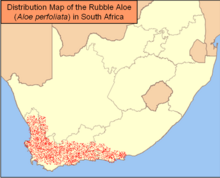Aloe perfoliata
| Aloe perfoliata | |
|---|---|
 |
|
| Scientific classification | |
| Kingdom: | Plantae |
| Clade: | Angiosperms |
| Clade: | Monocots |
| Order: | Asparagales |
| Family: | Asphodelaceae |
| Subfamily: | Asphodeloideae |
| Genus: | Aloe |
| Species: | A. perfoliata |
| Binomial name | |
|
Aloe perfoliata L. |
|
 |
|
| The natural range of Aloe perfoliata roughly matches the extent of Fynbos vegetation and the Cape Floristic Region | |
Aloe perfoliata, the rubble aloe or mitre aloe, is a hardy creeping aloe, found in rocky, mountainous areas throughout the Western Cape, South Africa.
Aloe perfoliata was formerly known as Aloe mitriformis. The physical appearance of this aloe varies greatly depending on environment, and consequently various sub-populations have previously often been mistaken for being separate species. The South African National Biodiversity Institute now recognizes that these are all members of the same species, Aloe perfoliata, comprising what were previously known as Aloe mitriformis, Aloe distans, Aloe comptonii, Aloe albispina and Aloe flavispina among others.
This species is the most widespread of a group of closely related "Creeping Aloes" (Mitriformes), including the cliff-hanging aloes A. meyeri and A. dabenorisana(stemless), as well as spotted Aloe arenicola of the South African west coast and the unusual Aloe pearsonii of the Richtersveld desert.
In their natural habitat, these aloes have long, prostrate, branching stems of up to 2 meters. Instead of growing upright, they tend to sprawl along the ground and over rocks. While most of the plant lies along the ground, the terminal leaf-bearing head is often erect, facing upwards to the sun. The leaf margins are armed with harmless, little white teeth.
The Rubble Aloe is extremely variable-looking, depending on its environment, making it difficult to identify sometimes. Plants growing in full sun develop tightly arranged bluish leaves, while those in the shade have more widely spaced green leaves. During dry conditions, the leaves assume a red colour. The thick, fleshy leaves often curve inwards during times of drought - making the rosette look rather like a mitre (until recently this species was known as Aloe mitriformis because of this resemblance).
Unlike most aloes which flower in winter, the Rubble Aloe flowers in summer. The red flowers appear on stalks, which (befitting the variable nature of this species) vary from being rounded to being cone-shaped.
...
Wikipedia
